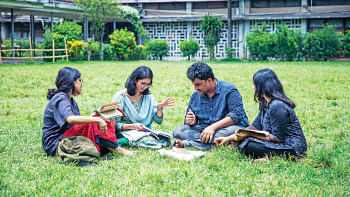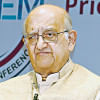Stop scapegoating the curriculum

Ever so often, education authorities unveil yet another revolutionary curriculum reform, promising to transform Bangladesh's youth into critical thinkers equipped for the global economy. The fanfare is predictable: glossy publications, enthusiastic press conferences, international consultants nodding approvingly. Meanwhile, in many (if not most) classrooms within a five-kilometre radius from the announcement ceremony, 60 students are crammed into a space designed for 30, memorising passages verbatim for their upcoming exams. Their teacher, untrained in the previous curriculum revision, is already anxious about implementing yet another change.
This national obsession with curriculum reform is not just ineffective, it is a charade masking deeper systemic failures while producing the illusion of progress. The curriculum is a favourite scapegoat, a convenient target for change that allows the authorities to appear progressive while avoiding the messy, politically challenging work of addressing the structural foundations that determine whether any curriculum should succeed or fail.
Consider the much-celebrated creative question method. Designed to foster higher-order thinking, it has instead mutated into another memorisation exercise, with students memorising creative answers from guidebooks. It collapsed not because the curricular concept was flawed, but because teachers (themselves products of a regressive iteration of the curricular legacy) received inadequate training, classrooms remained overcrowded, and the examination system continued to reward regurgitation rather than genuine creativity.
Our curriculum fixation serves vested interests. For politicians, it offers visible, announceable actions that suggest educational progress without demanding significant resource reallocation. For bureaucrats, it creates opportunities for workshops and committees. For development partners, it represents a tangible, measurable intervention that fits neatly into project documents and logframes. The curriculum becomes the perfect performative reform, visible enough to claim credit but divorced enough from classroom realities to avoid accountability for actual learning outcomes.
The National Education Policy, 2010 articulated a visionary curriculum emphasising creativity and critical thinking. A decade and a half later, we celebrate students achieving GPA 5 by reproducing memorised content while employers lament having to deal with graduates who are unable to draft a coherent email or solve basic workplace problems. Governments of all stripes have trumpeted the distribution of millions of free textbooks in January each year as a signature achievement, without addressing why the same textbooks gather dust as students rely on commercial guidebooks that better prepare them for exams.
This disconnect stems from a failure to recognise that the curriculum exists within an ecosystem. Curriculum is not equivalent to content delivery. It is also an experience to be facilitated. When we introduce digital learning objectives into a curriculum without ensuring reliable electricity supply at schools, when we prescribe student-centred pedagogy to teachers handling classes of around 70 students, when we mandate English communication while teachers themselves struggle with the language beyond declaring a patient dead before/after the doctor's arrival, we are engaging in educational fantasy, not reform.
The coaching centre culture exemplifies this dishonesty. These shadow institutions thrive not despite our curriculum reforms but because of them—they promise to translate the ideal curriculum into the practical reality of examination success. Their existence is a rational market response to the system's hypocrisy, where what is officially taught bears little resemblance to what is tested and valued. The madrasa education modernisation efforts follow the same flawed pattern. We revise religious education curricula to include modern subjects without addressing the pedagogical approaches, teacher qualifications or institutional cultures that determine whether these subjects are meaningfully taught.
Breaking this cycle requires confronting uncomfortable realities. First, no curriculum reform succeeds without a parallel investment in the human infrastructure of education. Teacher preparation isn't a supporting element of curriculum reform; it is part of the reform. Second, examination systems that reward memorisation will always undermine curricula designed for critical thinking. Third, the socioeconomic realities of Bangladesh, where education represents economic survival, mean that unless reforms address the connection between educational outcomes and life opportunities, they will remain theoretical exercises.
To redress, this author has a five-course wish list: a) establish a five-year moratorium on new curriculum changes to focus instead on implementing the existing curricula effectively; b) redirect curriculum reform budgets towards sustained, practice-based teacher development programmes; c) transform assessment systems to evaluate the ability of application, analysis, and problem-solving rather than recall; d) reduce class sizes by increasing the number of teachers rather than continually revising what those overwhelmed teachers are expected to teach; and e) elevate the teaching profession through improved compensation, autonomy, and social standing. This final point underlines an economic truth: value begets quality.
Granted, these measures are messier, more expensive, and politically challenging compared to the clean, donor-friendly process of curriculum revision. They require confronting entrenched interests and rethinking resource allocation. Yet, they address the actual antecedents of educational quality rather than its most visible but least consequential component.
Bangladesh's aspiration towards the higher middle-income status means we can no longer afford the luxury of educational theatre. The curriculum obsession is both a misdiagnosis of our educational ailments and a distraction from the cure. The next time officials proudly present a new curriculum, we should ask not what has changed on paper, but what will change in practice.
Dr Imtiaz Sifat is assistant professor and chair of international economics at Radboud University in the Netherlands. He can be reached at [email protected].
Views expressed in this article are the author's own.
Follow The Daily Star Opinion on Facebook for the latest opinions, commentaries and analyses by experts and professionals. To contribute your article or letter to The Daily Star Opinion, see our guidelines for submission.

 For all latest news, follow The Daily Star's Google News channel.
For all latest news, follow The Daily Star's Google News channel. 










Comments